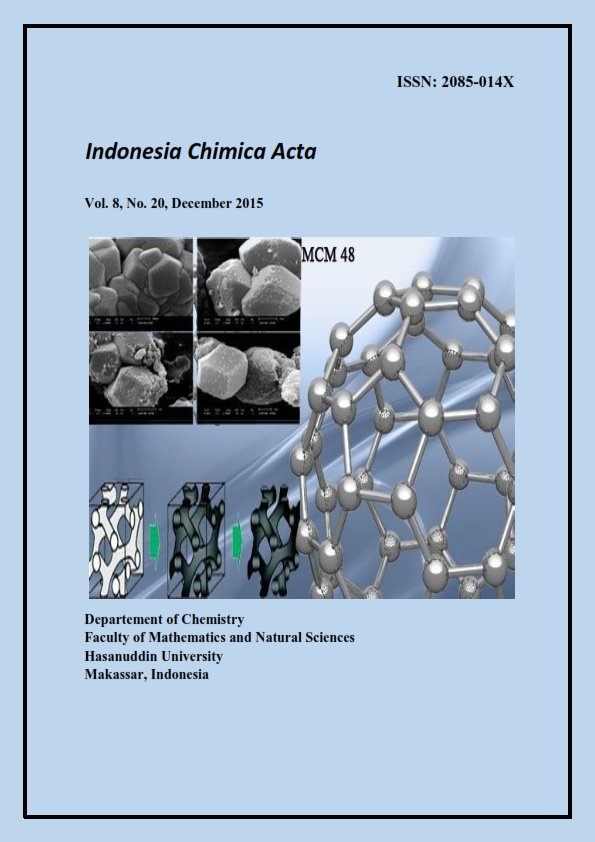Main Article Content
Abstract
Article Details
References
- Brusea, R., Brusea, G.J., 1990, Invertebrates, Sinauer Associates Inc, Massachussets.
- Cappucino, 1987, Microbiology:A Laboratory Manual, The Benjamin Cummings Publishing Company Inc, California.
- Dahuri, Rokhmin. 2003, Keanekaragaman Hayati Laut, PT Gramedi Pustaka Utama, Jakarta.
- Djide, M.N., 2003, Mikrobiologi Farmasi, Fakultas Matematika dan Ilmu Pengetahuan Alam, Universitas Hasanuddin. Makassar.
- Doerge, R. F., 1982, Wilson and Gisvold’s Textbook of Organic Medicinal and Pharmaceutical Chemistry, J.B. Lippincott Company, Pensilvania.
- Ganiswarna, S. 1995, Farmakologi dan terapi, Edisi IV, Bagian Farmakologi Fakultas Kedokteran Universitas Indonesia, Jakarta.
- Hansson, Hans G. 1998, South Scandinavian Marine Cnidaria, (On line), (http: www//.tmbl.gu.se.,diakses 19 Mei 2007).
- Huang. L, 1999, Protein dalam Air Mata Obat untuk AIDS?, (On line),(http://www.rad.net.id/warta/wao4701.htm, diakses 12 Juli 2005).
- Irianto, K. 2002, Mikrobiologi Menguak Dunia Mikroorganisme, Rama Widya, Bandung.
- Jasin, M. 1992, Zoologi Invertebrata, Penerbit Sinar Wijaya, Surabaya.
- Jawetz, E., Melnick, J.L. dan Adelberg, E.A. 1984, Mikrobiologi Untuk profesi Kesehatan, Terjemahan oleh H. Tonang, 1992, Jakarta: EGC Penerbit Buku Kedokteran.
- Katzung, BG. 1999, Farmakologi Dasar dan Klinik, Penerbit Salemba Medika, Surabaya.
- Kozloff, Eugene N. 1990, Invertebrates. Saunders College Publishing, United States.
- Krieg, N. R., 1984, Bergey’s Manual Systematic Bacteriology Vol.1, Baltimore, London.
- Kusen, J.D., 1993, Dinamika KeanekaragamanTerumbu Karang dan Peranannya Terhadap Perkembangan Wilayah Pesisir,Prosiding Lokakarya Nasional Penyusunan Program Penelitian Biologi Kelautan dan Proses Dinamika Pesisir, LIPI, Jakarta.
- Maskoeri, J. 1992, Zoologi Invertebrata, Penerbit Sianar Wijaya, Surabaya.
- Mahon, C. R., G. Manuselis., 1995, Textbook of Diagnostic Microbiology, W. B. Saunders Company, Tokyo.
- Majalah Poultry Indonesia. 2 Agustus, 2003, Ada Protein Antimikroba Dalam Sekantung Susu.
- McConnaughey, Bayard H. 1987, Introduction To Marine Biology, The C. V. Mosby Company, Saint Louis.
- Montgomery, R., Conway, T.W. dan Spector, A.A. 1992, Biokimia Berorientasi pada Kasus Klinik, Terjemahan oleh Staf Pengajar bagian Biokimia Fakultas Kedokteran Universitas Indonesia. 1993, Jakarta: Binarupa Aksara.
- Naim, R. 2003, Ada Protein Antimikroba Dalam Sekantong Susu, (On line), (http://www.poultryindonesia.com/modules.php?name=News&file=article&sid=237, diakses 9 Juli 2005).
- Pelczar, M.J. dan Chan, E.C.S. 1988, Dasar-Dasar Mikrobiologi 2, Terjemahan oleh Ratna Siri, Teja Imas, S.Sutarmi, Sri Lestari Langka. Jakarta: penerbit Universitas Indonesia.
- Page, D.S. 1985, Prinsip-prinsip Biokimia. Edisi kedua. Jakarta: Erlangga.
- Rismana,E. 2001, Biota Laut Berpotensi Besar jadi Sumber Bahan Baku Obat dari Industri Farmasi, (Online),(file://A:Biota%20Laut%20Berpotensi%20Besar.htm, diakses 25 Januari 2002).
- Ruppert, E.E., Barnes, R.D. 1993, Invertebrata Zoolgy, Sixth Edition. Saunders College Publishing, United States.
- Setiono, P. 2002., Infeksi Bakteri Intraseluler Pada Anak. (On line), http://www.Pediatrik.com/kanalpkb34/01InfeksiBakteriIntraselulerParwatiSB.pdf, diakses 25 oktober 2005).
- Suparno, 2005, Kajian Bioaktif Spons Laut(Porifera: Demospongiae) Suatu Peluang Alternatif Pemanfaatan Ekosistem Karang Indonesia dalam Bidang Farmasi, (On line), http://72.14.203.104/search?q=cache:uflSEp5vNhoJ:tumoutou.net/pps702_10245/suparno, diakses 9 September 2005).
- Setyaningsih. 2004, Resistensi bakteri dan Antibiotik Alami dari Laut, (Online),(http://72.14.203.104/search?q=cache7y-24YyXJEJ:tumoutou.net/pps702_9145/Iriani_sety, diakses 9 September 2005).
- Wattimena, J.R. 1991, Farmakodinamika dan terapan Antibiotik. Gadjah Mada University Press. Yogyakarta.
- Wheeler, F.M., Volk, A.W., 1988, Mikrobiologi Dasar Jilid I, Erlangga. Jakarta.
- Wiryowidagdo, S. 2007, Potensi Obat Dari Laut Belum Dimaksimalkan,(Online),(http://www.bppt.go.id/index.php?option=com_content&task=view&id=1548&Itemid=30, diakses 25 Mei 2007).
References
Brusea, R., Brusea, G.J., 1990, Invertebrates, Sinauer Associates Inc, Massachussets.
Cappucino, 1987, Microbiology:A Laboratory Manual, The Benjamin Cummings Publishing Company Inc, California.
Dahuri, Rokhmin. 2003, Keanekaragaman Hayati Laut, PT Gramedi Pustaka Utama, Jakarta.
Djide, M.N., 2003, Mikrobiologi Farmasi, Fakultas Matematika dan Ilmu Pengetahuan Alam, Universitas Hasanuddin. Makassar.
Doerge, R. F., 1982, Wilson and Gisvold’s Textbook of Organic Medicinal and Pharmaceutical Chemistry, J.B. Lippincott Company, Pensilvania.
Ganiswarna, S. 1995, Farmakologi dan terapi, Edisi IV, Bagian Farmakologi Fakultas Kedokteran Universitas Indonesia, Jakarta.
Hansson, Hans G. 1998, South Scandinavian Marine Cnidaria, (On line), (http: www//.tmbl.gu.se.,diakses 19 Mei 2007).
Huang. L, 1999, Protein dalam Air Mata Obat untuk AIDS?, (On line),(http://www.rad.net.id/warta/wao4701.htm, diakses 12 Juli 2005).
Irianto, K. 2002, Mikrobiologi Menguak Dunia Mikroorganisme, Rama Widya, Bandung.
Jasin, M. 1992, Zoologi Invertebrata, Penerbit Sinar Wijaya, Surabaya.
Jawetz, E., Melnick, J.L. dan Adelberg, E.A. 1984, Mikrobiologi Untuk profesi Kesehatan, Terjemahan oleh H. Tonang, 1992, Jakarta: EGC Penerbit Buku Kedokteran.
Katzung, BG. 1999, Farmakologi Dasar dan Klinik, Penerbit Salemba Medika, Surabaya.
Kozloff, Eugene N. 1990, Invertebrates. Saunders College Publishing, United States.
Krieg, N. R., 1984, Bergey’s Manual Systematic Bacteriology Vol.1, Baltimore, London.
Kusen, J.D., 1993, Dinamika KeanekaragamanTerumbu Karang dan Peranannya Terhadap Perkembangan Wilayah Pesisir,Prosiding Lokakarya Nasional Penyusunan Program Penelitian Biologi Kelautan dan Proses Dinamika Pesisir, LIPI, Jakarta.
Maskoeri, J. 1992, Zoologi Invertebrata, Penerbit Sianar Wijaya, Surabaya.
Mahon, C. R., G. Manuselis., 1995, Textbook of Diagnostic Microbiology, W. B. Saunders Company, Tokyo.
Majalah Poultry Indonesia. 2 Agustus, 2003, Ada Protein Antimikroba Dalam Sekantung Susu.
McConnaughey, Bayard H. 1987, Introduction To Marine Biology, The C. V. Mosby Company, Saint Louis.
Montgomery, R., Conway, T.W. dan Spector, A.A. 1992, Biokimia Berorientasi pada Kasus Klinik, Terjemahan oleh Staf Pengajar bagian Biokimia Fakultas Kedokteran Universitas Indonesia. 1993, Jakarta: Binarupa Aksara.
Naim, R. 2003, Ada Protein Antimikroba Dalam Sekantong Susu, (On line), (http://www.poultryindonesia.com/modules.php?name=News&file=article&sid=237, diakses 9 Juli 2005).
Pelczar, M.J. dan Chan, E.C.S. 1988, Dasar-Dasar Mikrobiologi 2, Terjemahan oleh Ratna Siri, Teja Imas, S.Sutarmi, Sri Lestari Langka. Jakarta: penerbit Universitas Indonesia.
Page, D.S. 1985, Prinsip-prinsip Biokimia. Edisi kedua. Jakarta: Erlangga.
Rismana,E. 2001, Biota Laut Berpotensi Besar jadi Sumber Bahan Baku Obat dari Industri Farmasi, (Online),(file://A:Biota%20Laut%20Berpotensi%20Besar.htm, diakses 25 Januari 2002).
Ruppert, E.E., Barnes, R.D. 1993, Invertebrata Zoolgy, Sixth Edition. Saunders College Publishing, United States.
Setiono, P. 2002., Infeksi Bakteri Intraseluler Pada Anak. (On line), http://www.Pediatrik.com/kanalpkb34/01InfeksiBakteriIntraselulerParwatiSB.pdf, diakses 25 oktober 2005).
Suparno, 2005, Kajian Bioaktif Spons Laut(Porifera: Demospongiae) Suatu Peluang Alternatif Pemanfaatan Ekosistem Karang Indonesia dalam Bidang Farmasi, (On line), http://72.14.203.104/search?q=cache:uflSEp5vNhoJ:tumoutou.net/pps702_10245/suparno, diakses 9 September 2005).
Setyaningsih. 2004, Resistensi bakteri dan Antibiotik Alami dari Laut, (Online),(http://72.14.203.104/search?q=cache7y-24YyXJEJ:tumoutou.net/pps702_9145/Iriani_sety, diakses 9 September 2005).
Wattimena, J.R. 1991, Farmakodinamika dan terapan Antibiotik. Gadjah Mada University Press. Yogyakarta.
Wheeler, F.M., Volk, A.W., 1988, Mikrobiologi Dasar Jilid I, Erlangga. Jakarta.
Wiryowidagdo, S. 2007, Potensi Obat Dari Laut Belum Dimaksimalkan,(Online),(http://www.bppt.go.id/index.php?option=com_content&task=view&id=1548&Itemid=30, diakses 25 Mei 2007).
